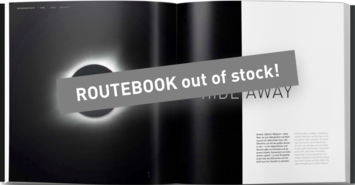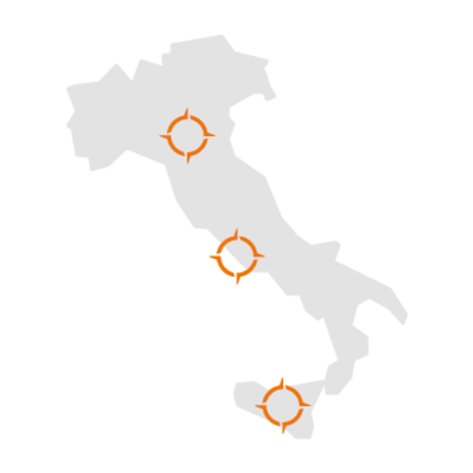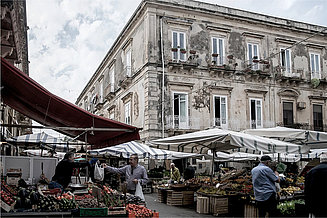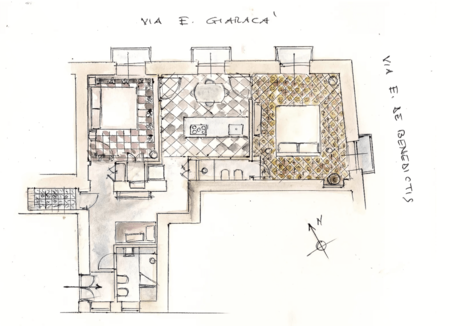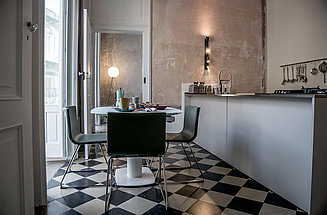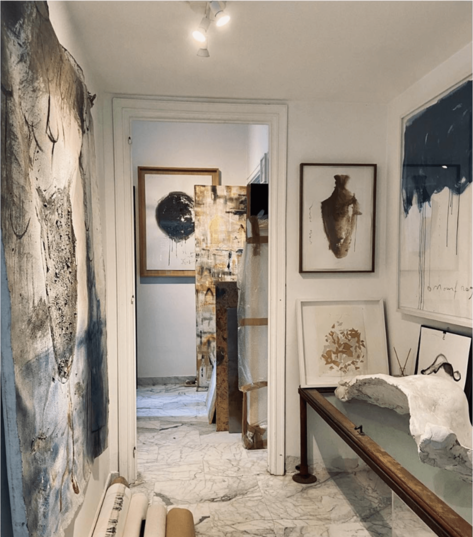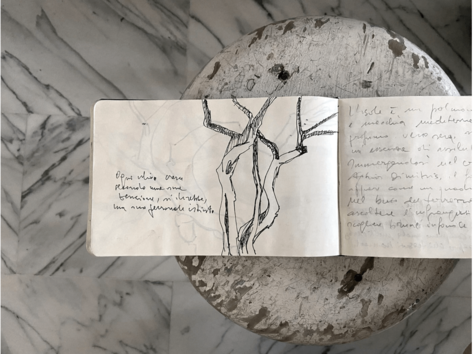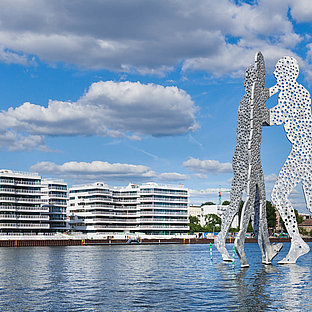The empathic Traveller
8 min readBorn in Bologna, Luca Giannini is a modern Leonardo da Vinci. With the weightlessness and assurance of a cosmonaut, he glides effortlessly from one discipline and destination to another and brings them coherently together: Art, design, architecture, craft and photography. Myth and matter, sea and land, symbol and archetype, space and time. At home in Sicily, Rome and Bologna but also wherever a place makes his soul sing, his travel experiences and deep empathy for locations manifest in meaningful yet wonderfully quiet works and projects.
His Taccuini di viaggio – very personal travel notebooks – reveal a particularly sensitive impression of places: hidden corners, unexpected perspectives, lighting moods, patina and whispered secrets. A feeling, a déjà vu, a fleeting encounter and all the stories and messages that are born out of stillness.
In Sicily, Luca welcomes his guests in houses that – once abandoned, dilapidated ruins - in a quiet and sublime way, contain a whole cosmos, permeated through and through by the light and soul of the South: Hortus Residence and Casa Sabir.
I met Luca for an interview on a spring-like January day in Rome. The outcome was a long, inspiring conversation about the nature of places, their treasures and revelations. A conversation about the South and the longing for the meaning and spirit of the Grand Tour. About borders and border crossers, islands and freedom, about the love of travel and very personal resolutions. In short: In a conversation about what makes us come alive. Take your time.
Interview by Britta Krämer www.urlaubsarchitektur.de January 2022
The spirit of places, their historical, symbolic and emotional power play a central role in your works and projects. Why do we feel so deeply connected to certain places?
Our soul does not vibrate the same in every place. We resonate most strongly with those places that hold up a mirror to us, in which we discover essential parts of ourselves. Places whose sublime energy allows us to sense the common thread, the larger context of our existence; places that invite us to pause, contemplate, listen and observe, and that align to our search for freedom and meaning. We become ‘empathic’ with these places, etymologically we ‘suffer’ with them, because their particular nature corresponds to our very own natural sensations.
Areas that particularly appeal to me are places on borders, where the dividing line between elements or between peoples becomes apparent: Along borders, as we know, nature produces the greatest biodiversity, cultures mingle and enrich each other and create new, more interesting forms of existence.
I have a natural affinity for the Mediterranean. In this melting pot of myths and archetypes, all of which are connected with my own origins, I feel the closest to my authentic self. And on the islands, at the edge of where the finiteness of the land meets the infinity of the sea, the deeper meaning of human history opens up to me more freely.
Being objective in a place is purely abstraction, because we always create a subjective, very personal perception through our senses and our mind. The story of a place always reveals itself to us in a very personal way, just as every travel experience is entirely subjective. My way of travelling and narrating a place is born from the desire to build a relationship, to share a common feeling. My approach to reality is poetic, it is done through emotional images from which visions emerge.
Your creative journey has concrete geographical references. What are your coordinates of the muse?
In principle, I am a photosynthetic person; light activates my visual imagination. My life, so far, has been a gravitation towards the South, which I associate with certain inclinations of the soul: with the need for light, with allowing chaos and the unpredictable, with the sensual experience of a world where nature is more rugged, more intense, capable of extremes and rich in limitations and contrasts. Here I become immersed in the complex history of the Mediterranean, where ancient memories and archaic knowledge are rooted and where history, beyond dusty museums, is intertwined in the daily life of the inhabitants.
Bologna, my hometown, with its soft, pastel light and its vociferous directness, has given me a lyrical approach to things and a sense of hospitality. Rome, with its lively chaos that typifies the South, with the vastness of its horizons, its thousand identities, its lush Baroque backdrops, its peeling surfaces and stones marked by time, was the ‘midwife’ of my career as an artist interested in matter, signs and symbols.
The Sicily of Modica, Syracuse and the Noto Valley, with its African-like chalky light and its colourful shadows, is a playground of opposing forces, contrasting yet complementary energies, a permeable frontier of Mediterranean cultures. It was here that I first heard the cry of abandoned places and the desire to breathe new life into them by opening them up to hospitality. It was here that my project Anime a Sud was born over 15 years ago.
Painting, sculpting, architecture, design, photography and all their crossovers. Your works and projects draw from a wide variety of disciplines and have multi-layered levels of meaning. Yet they always remain clear, simple and quiet.
In our time there has been too much emphasis in differentiations and specializations. However in the past, the architect was also an engineer, a thinker, a craftsman, an artist, a traveller and an astronomer. He knew the movements of the stars, the properties of matter, the rules of geometry, the canons of aesthetics and the schools of philosophy.
It's true, I also move between disciplines, because basically, like travel, I'm concerned with crossing borders: it opens up and expands the possibilities of dialogue.
My approach to the architecture of a place is artistic. I treat it like a sculpture, explore the artistic movements it reveals, look at its full extent, pay attention to the variation of light, strive for the balance of fullness and emptiness, explore the delicate balance between addition and omission that defines the perfection of a space.
As long as I feel that an environment is not clarified or a work is not really finished, I feel a kind of imbalance, an almost physical discomfort, because my design approach is basically physiological: in a well-organized environment or in front of a work well done, my body relaxes and I feel at ease. The material also plays an important role.
My artistic works revolve around Mediterranean symbols (the amphorae), myths of origin (the Garden of Eden, the Ark, the world egg, the constellations), maps and routes of real or imaginary journeys (the maps of the new worlds) and forms related to the ecological crisis of our planet (whales, planets). These are material-
related works, where one can see and understand the layers, the indecision, the pausing, the changes of direction. Our lives are ultimately shaped in the same way and are individual and unique. I see no point in copies, imitations and standardizations - no matter what the discipline.
Materials should be presented according to their true nature and used near their place of origin. The design should be about finding independent solutions that refer to the symbols and traditions of a place. The projects I conceive are always very much related to crafts, they want to convey a sense of uniqueness, to make where they are located comprehensible. They make up the essence of a place, its people and their talents, its stones and colours the main actor.
I take photos in a similar way. I want to capture the mystery of a place, the hidden, the not obvious. I am interested in shadows as much as in the light, in the balance of the masses, in the imaginary signs created by the different perspectives.
You bring abandoned places back to life. The ‘memory’ of these places plays an essential role here.
Reviving a place has to do with ethics and our planet. Not wasting new terrain, conserving natural resources, and making a ruin or abandoned building accessible to the community are environmental and social issues that have always concerned me.
Bringing a place back to life also has a ritual significance: honouring the genius loci - in classical Roman religion the spiritual protector of a place. Ancient people received messages and premonitions from the world around them and also lived them on a symbolic level. They knew that not all places on earth were the same, but that energies were concentrated in certain places where nature produced its peculiar qualities; here they built temples and sanctuaries or marked the borders of cities.
In his book The Soul of Places, the American philosopher and psychologist James Hillman, in conversation with the Italian architect and writer Carlo Truppi, states that places have a memory,and that to restore a place is also to cure an amnesia, to repair an erased memory:‘It is as if they asked to be abandoned, to suffer exclusion, only to be fully rediscovered, revealing their deeper identity. In this way they become real: places of which it can be said that they were born twice.’
Listening to a place is closely linked to time. I like to dwell in one place for a long time so that my imagination can tune in. Heidegger said: ‘Man resides poetically’. Dreams and visions are the catalyst for restoring a place and giving poetry back to the function of dwelling.
Your Taccuini di viaggio, which you make for yourself privately and as a commissioned work, portray the intimate character of Siracusa,
Salina, Essaouira and other destinations. With an attentive eye they capture everyday and seemingly trivial facets. For me, browsing and reading your ‘sketched narratives’ was as if I had been given a key to the place in question, as if I had walked through it myself and made its mood mine.
When I read travel literature, I am always amazed at how much one's connection to a place and the people who live there depends on the time and mindful observation one devotes to it. They are in marked contrast to the hectic pace of our society, the abuse of visual communication, the bulimia of images, the superficial and stereotypical representation of places. Last minute, one-day business trips, short vacations, no time for travel preparation. The speed of change of place prevents us from arriving with the proper mood, and often we are already so saturated with pre-chewed information that we miss the chance to really engage with our destination.
Knowing a place means feeling and sensing it, depositing emotions in it and receiving vibrations from it. For this we need a phase of calm, a receptive attitude, an equal dialogue between us and the place. In this way it is no longer passively consumed; instead it becomes an active source of impulses for sensations and inspiration.
Modern society has greatly shortened the time of travel, transforming it into vacation (vacanza/vacation), which etymologically comes from ‘vacare’, meaning ‘to be absent’. So a lack, so-to-speak, an absence. Our frenetic everyday life is compensated with complete disconnection when we're on holiday. The travellers of the past, on the other hand, travelled for the sake of travel, they were always completely present, their senses were active and they were intent, indeed, eager! to absorb all the messages of a place.
The ancient Romans called otium the time which is the opposite of negotium, but attributed to it an equally useful role in the cultivation of the mind. The travellers who embarked on the Grand Tour knew that they had an extraordinary learning opportunity before them and that when they returned months or even years later, they would be different people. They also knew that the trip might bring unforeseen events, they had the time and the will to indulge in them and even learn from them. Experiences that we can no longer afford in our over-regulated world that feeds our fears with the utopia of zero risk.
Sketching a place is in itself a way of decelerating: to allow the light to change its properties, to discover hidden details, to sharpen our senses so that we can perceive more subtle smells and sounds. Sometimes an unexpected chance encounter even arises, contributing to a deeper and more authentic knowledge of the place. Ultimately, a place tells as much about me as I do about it, and through it I also tell about myself.
You've written eight principles for yourself that you've firmly embedded in your daily life. They read like a personal manifesto, like a ‘bucket list’ of mindfulness.
- To rid myself of the superfluous while preserving what inspires me in terms of function and beauty
- Making time, physical matter and the rhythm of nature useful to me again
- Nourish myself well, physically with healthy food and spiritually with projects that bring out my potential
- Finding the balance between dream and reality
- Maintain constructive and enriching relationships and discard those that conflict with my principles
- Avoid letting fear control the decisions I make or do not make
- Travel consciously, in line with my spiritual inclination and inner disposition, and with my soul open to all sensations
- Make mindful choices every day that protect the planet
These eight principles are an important guide that enrich my life. They concern my natural predispositions, my visions, my hopes, but also my blockages and limitations, which I would like to work on. They concern my relationship with possessions and the focus on essential needs that are really important for my soul. They concern my soul and my body, both of which need to be nourished in a natural, healthy and balanced way. They describe the often blurred lines between my quest for comfort and the dictates of gravity, between the dream and vision that guide my gaze into the distance and the rational diligence neededto manifest the dream in a creative project.
They remind me ‘nurture and tend to my relationships’, to nourish the constructive relationships and keep out the destructive ones. They concern my handling of fear and its frightening, limiting and misleading effects, the acceptance of mistakes and the ability to see opportunity beyond adversity.
They remind me of the way I want to travel, my ability to deal with the unexpected, having a healthy relationship with time, developing my physiological perception of places, recognising those places that convey harmony, and listening without prejudice to the people I meet. They concern my daily relationship with my immediate environment, my sense of responsibility for what I leave behind, and what I take away or change, and the conscious actions and decisions resulting from this. As I read these principles, I find myself thinking of the islands – of their dual dimension of being both a sanctuary and a prison, at the same time an invitation to come and a call to leave. I think of their clear aura of detachment, the modesty of their demands, the creative energy inspired their intrinsic nature as well as their role as catalysts for negative and positive emotions. I think of the originality of their products from land and sea, of their ability to muffle the background noise of our noisy civilization, of their relationship with solitude and one's own fears. For me, islands are a laboratory of self-discovery. our noisy civilization, of the relationship with solitude and with one's own fears. For me, islands are a laboratory of self-discovery.
Order the ROUTEBOOK now
Are you an interior designer or architect? Then order our exclusive "Look and Feel" book free of charge and let yourself be touched visually, ideally and haptically.
Due to the large number of orders, our ROUTEBOOK is unfortunately currently out of stock.The next edition will be published as early as autumn 2023, which you can pre-order here.
Order now To the archive